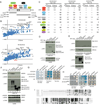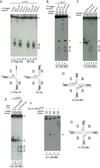Mammalian BTBD12/SLX4 assembles a Holliday junction resolvase and is required for DNA repair
- PMID: 19596235
- PMCID: PMC2720686
- DOI: 10.1016/j.cell.2009.06.030
Mammalian BTBD12/SLX4 assembles a Holliday junction resolvase and is required for DNA repair
Abstract
Structure-specific endonucleases mediate cleavage of DNA structures formed during repair of collapsed replication forks and double-strand breaks (DSBs). Here, we identify BTBD12 as the human ortholog of the budding yeast DNA repair factor Slx4p and D. melanogaster MUS312. Human SLX4 forms a multiprotein complex with the ERCC4(XPF)-ERCC1, MUS81-EME1, and SLX1 endonucleases and also associates with MSH2/MSH3 mismatch repair complex, telomere binding complex TERF2(TRF2)-TERF2IP(RAP1), the protein kinase PLK1 and the uncharacterized protein C20orf94. Depletion of SLX4 causes sensitivity to mitomycin C and camptothecin and reduces the efficiency of DSB repair in vivo. SLX4 complexes cleave 3' flap, 5' flap, and replication fork structures; yet unlike other endonucleases associated with SLX4, the SLX1-SLX4 module promotes symmetrical cleavage of static and migrating Holliday junctions (HJs), identifying SLX1-SLX4 as a HJ resolvase. Thus, SLX4 assembles a modular toolkit for repair of specific types of DNA lesions and is critical for cellular responses to replication fork failure.
Figures







Comment in
-
Breaking up just got easier to do.Cell. 2009 Jul 10;138(1):20-2. doi: 10.1016/j.cell.2009.06.039. Cell. 2009. PMID: 19596231
References
-
- Boddy MN, Gaillard PH, McDonald WH, Shanahan P, Yates JR, 3rd, Russell P. Mus81-Eme1 are essential components of a Holliday junction resolvase. Cell. 2001;107:537–548. - PubMed
-
- Chen XB, Melchionna R, Denis CM, Gaillard PH, Blasina A, Van de Weyer I, Boddy MN, Russell P, Vialard J, McGowan CH. Human Mus81-associated endonuclease cleaves Holliday junctions in vitro. Mol Cell. 2001;8:1117–1127. - PubMed
-
- Ciccia A, Constantinou A, West SC. Identification and characterization of the human mus81-eme1 endonuclease. J Biol Chem. 2003;278:25172–25178. - PubMed
-
- Ciccia A, McDonald N, West SC. Structural and functional relationships of the XPF/MUS81 family of proteins. Annu Rev Biochem. 2008;77:259–287. - PubMed
Publication types
MeSH terms
Substances
Grants and funding
LinkOut - more resources
Full Text Sources
Other Literature Sources
Molecular Biology Databases
Research Materials
Miscellaneous

